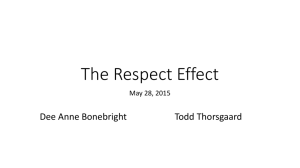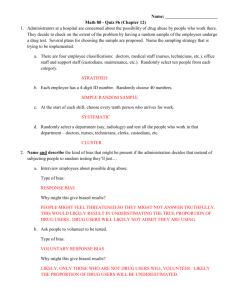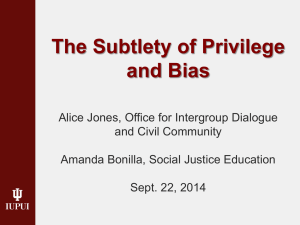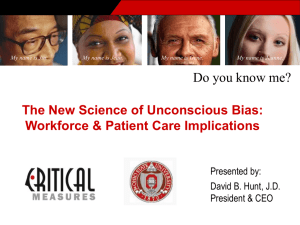The Biological Origins of Bias
advertisement
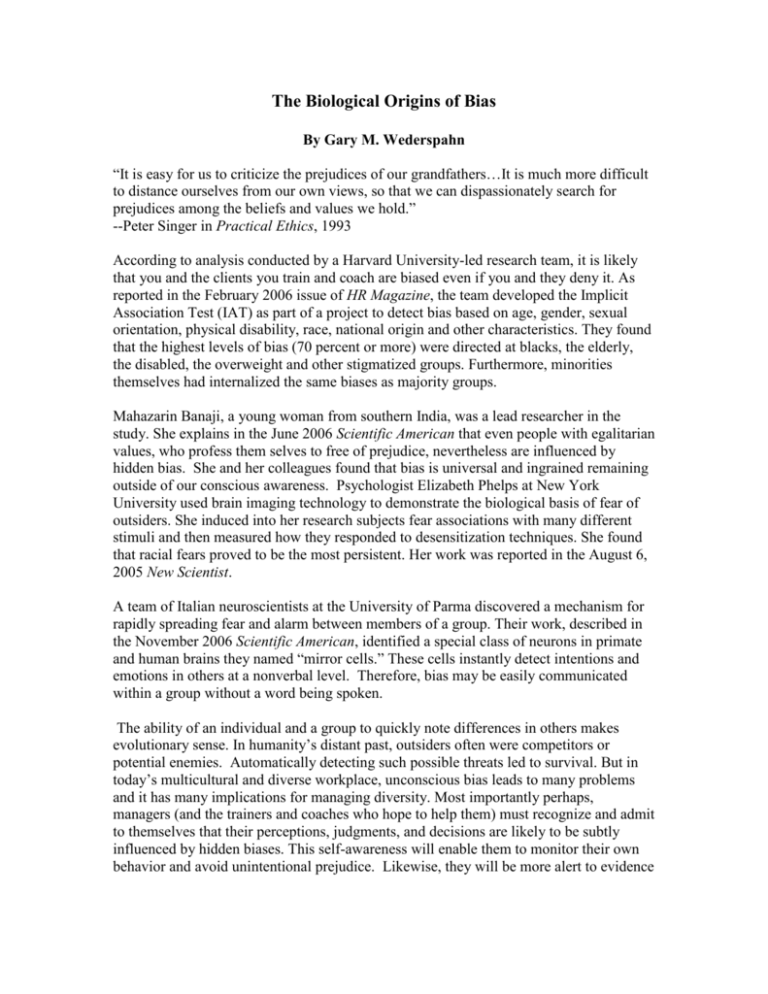
The Biological Origins of Bias By Gary M. Wederspahn “It is easy for us to criticize the prejudices of our grandfathers…It is much more difficult to distance ourselves from our own views, so that we can dispassionately search for prejudices among the beliefs and values we hold.” --Peter Singer in Practical Ethics, 1993 According to analysis conducted by a Harvard University-led research team, it is likely that you and the clients you train and coach are biased even if you and they deny it. As reported in the February 2006 issue of HR Magazine, the team developed the Implicit Association Test (IAT) as part of a project to detect bias based on age, gender, sexual orientation, physical disability, race, national origin and other characteristics. They found that the highest levels of bias (70 percent or more) were directed at blacks, the elderly, the disabled, the overweight and other stigmatized groups. Furthermore, minorities themselves had internalized the same biases as majority groups. Mahazarin Banaji, a young woman from southern India, was a lead researcher in the study. She explains in the June 2006 Scientific American that even people with egalitarian values, who profess them selves to free of prejudice, nevertheless are influenced by hidden bias. She and her colleagues found that bias is universal and ingrained remaining outside of our conscious awareness. Psychologist Elizabeth Phelps at New York University used brain imaging technology to demonstrate the biological basis of fear of outsiders. She induced into her research subjects fear associations with many different stimuli and then measured how they responded to desensitization techniques. She found that racial fears proved to be the most persistent. Her work was reported in the August 6, 2005 New Scientist. A team of Italian neuroscientists at the University of Parma discovered a mechanism for rapidly spreading fear and alarm between members of a group. Their work, described in the November 2006 Scientific American, identified a special class of neurons in primate and human brains they named “mirror cells.” These cells instantly detect intentions and emotions in others at a nonverbal level. Therefore, bias may be easily communicated within a group without a word being spoken. The ability of an individual and a group to quickly note differences in others makes evolutionary sense. In humanity’s distant past, outsiders often were competitors or potential enemies. Automatically detecting such possible threats led to survival. But in today’s multicultural and diverse workplace, unconscious bias leads to many problems and it has many implications for managing diversity. Most importantly perhaps, managers (and the trainers and coaches who hope to help them) must recognize and admit to themselves that their perceptions, judgments, and decisions are likely to be subtly influenced by hidden biases. This self-awareness will enable them to monitor their own behavior and avoid unintentional prejudice. Likewise, they will be more alert to evidence of bias on the part of their subordinates and coworkers in order to take appropriate action promptly. If unconscious bias is seen as universal, normal, and inevitable it need not be considered a source of shame, guilt or a personal defect. Instead, it can be dealt with openly and managed as an entirely expected human characteristic. Biology is not necessarily destiny. The research shows that positive personal interaction between people from different ethic, racial and cultural backgrounds leads to a reduction in the neurological markers of bias. Well-designed diversity and intercultural training and coaching delivered by skilled professionals who are fully aware of the depth and extent of the challenge, has the best chance of facilitating this change. We practitioners have the responsibility to keep ourselves informed of scientific developments that shed light on our assumptions, beliefs and practices. Likewise, we need to share the profound implications of this research with our colleagues and clients. Byline: Gary M. Wederspahn is an intercultural, consultant, coach, trainer and speaker. He is author of Intercultural Services: A Worldwide Buyer’s Guide and Sourcebook. He can be reached online at www.intercultural-help.com.

